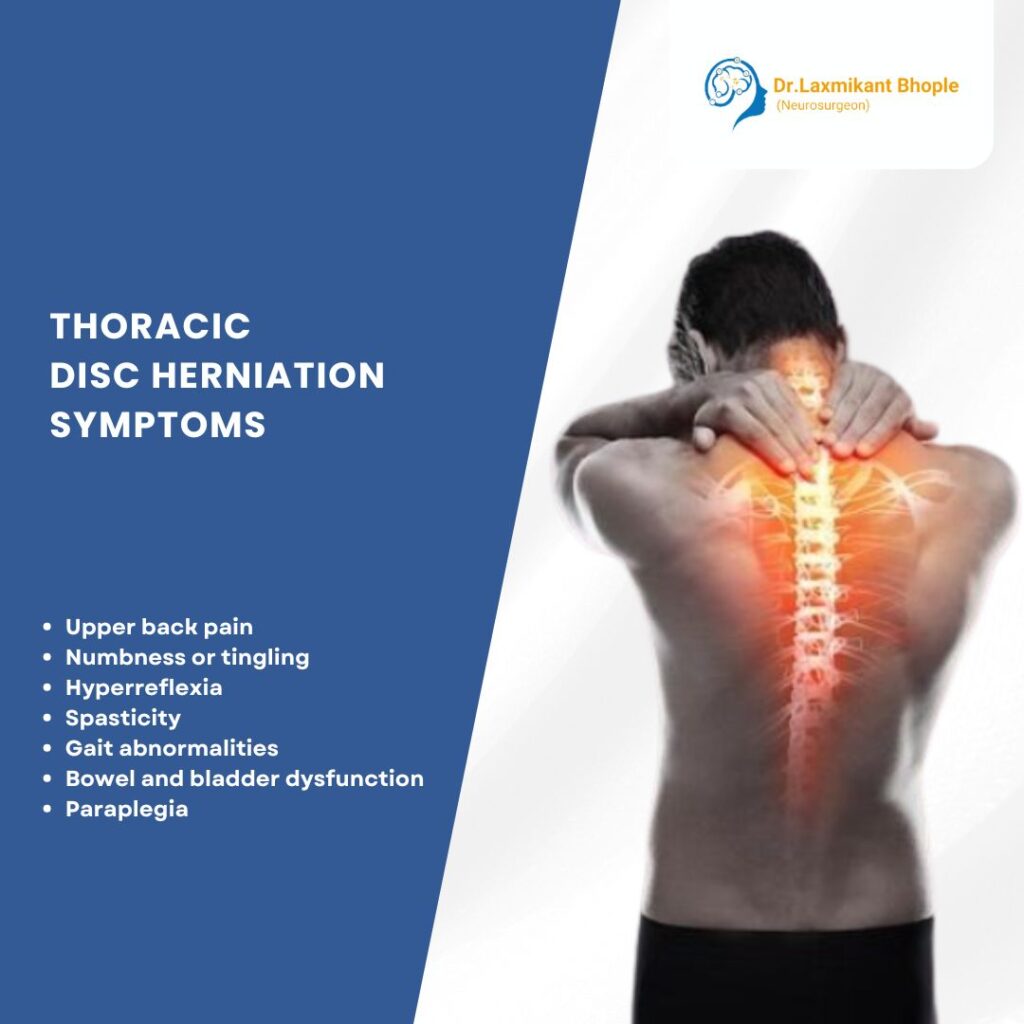Thoracic disc herniation is a condition where an intervertebral disc in the thoracic spine (mid-back) bulges or ruptures, compressing the spinal cord or nearby nerves. While this condition is less common than cervical or lumbar disc herniation, it can cause significant discomfort and neurological symptoms. Seeking medical attention from a Spinal Surgeon and Neurologist in Nanded can help in diagnosing and managing this condition effectively. Thoracic Disc Herniation can cause pain, numbness, and mobility issues. Learn about symptoms, diagnosis, and treatment options.
Symptoms of Thoracic Disc Herniation
1. Upper Back Pain
One of the primary symptoms of thoracic disc herniation is persistent pain in the upper back. The pain may be localized or radiate to the chest, ribs, or abdomen.
Characteristics of Upper Back Pain:
- Dull, aching discomfort
- Sharp pain when moving, twisting, or bending
- Worsens with prolonged sitting or physical activity
Why It Occurs:
The herniated disc puts pressure on surrounding nerves and spinal structures, causing inflammation and pain.
2. Numbness or Tingling
Patients may experience numbness or tingling sensations in the affected areas, often extending to the chest, abdomen, or lower body.
Commonly Affected Areas:
- Chest and ribcage
- Abdomen
- Lower extremities in severe cases
Why It Occurs:
Compression of the nerve roots or spinal cord interferes with normal sensory signals, leading to these abnormal sensations.
3. Hyperreflexia
Hyperreflexia, or overactive reflexes, is a sign of spinal cord compression, often indicating a more severe case of thoracic disc herniation.
Signs of Hyperreflexia:
- Exaggerated reflex responses
- Involuntary muscle contractions
- Clonus (repetitive muscle spasms)
Why It Occurs:
Spinal cord compression disrupts normal nerve signaling, leading to exaggerated reflex activity.
4. Spasticity
Spasticity refers to muscle stiffness and involuntary muscle contractions, making movement difficult and painful.
Symptoms of Spasticity:
- Muscle tightness in the legs or torso
- Difficulty with fine motor skills
- Increased resistance to passive movements
Why It Occurs:
Spinal cord involvement leads to impaired nerve control over muscles, causing stiffness and spasms.
5. Gait Abnormalities
Difficulty walking or maintaining balance can be an early sign of thoracic disc herniation affecting the spinal cord.
Common Gait Issues:
- Unsteady walking
- Tripping or stumbling frequently
- Dragging one leg while walking
Why It Occurs:
Nerve compression affects coordination and motor control, leading to walking difficulties.
6. Bowel and Bladder Dysfunction
Severe cases of thoracic disc herniation can lead to problems with bowel and bladder control, a condition that requires immediate medical attention.
Symptoms Include:
- Difficulty urinating or increased frequency
- Bowel incontinence or constipation
- Loss of sensation in the pelvic area
Why It Occurs:
Nerve compression in the thoracic spine can interfere with signals that control bowel and bladder function.
7. Paraplegia
In extreme cases, untreated thoracic disc herniation can lead to paraplegia, or loss of movement and sensation in the lower body.
Symptoms of Paraplegia:
- Complete or partial loss of leg function
- Loss of sensation below the affected spinal level
- Need for assistive devices like wheelchairs
Why It Occurs:
Severe spinal cord compression can damage nerve pathways responsible for lower-body movement.
Diagnosis of Thoracic Disc Herniation
Diagnosing thoracic disc herniation involves a thorough medical evaluation, imaging tests, and neurological assessments.
Diagnostic Procedures:
- Physical Examination: Evaluates reflexes, muscle strength, and sensation.
- MRI Scan: Provides detailed images of spinal discs and nerve compression.
- CT Scan: Used to assess bony structures and disc damage.
- Electromyography (EMG): Measures nerve function and detects abnormalities.
Seeking an evaluation from a Spinal Surgeon and Neurologist in Nanded ensures accurate diagnosis and proper treatment planning.

Treatment Options for Thoracic Disc Herniation
Treatment depends on the severity of symptoms and the degree of spinal cord involvement.
Non-Surgical Treatments:
- Medications: Pain relievers, anti-inflammatory drugs, and muscle relaxants
- Physical Therapy: Strengthens muscles, improves flexibility, and reduces pain
- Epidural Steroid Injections: Reduces inflammation and provides temporary pain relief
Surgical Options:
If non-surgical treatments fail or symptoms worsen, surgery may be necessary.
Types of Surgery:
- Discectomy: Removes the herniated portion of the disc
- Spinal Fusion: Stabilizes the spine by fusing two vertebrae
- Laminectomy: Removes a portion of the vertebra to relieve pressure
A Spinal Surgeon and Neurologist in Nanded can determine the best surgical approach based on the patient’s condition.
Risk Factors for Thoracic Disc Herniation
Several factors increase the likelihood of developing a herniated disc in the thoracic spine.
Common Risk Factors:
- Age: Disc degeneration occurs naturally with aging.
- Poor Posture: Prolonged slouching or improper ergonomics strain the spine.
- Heavy Lifting: Lifting heavy objects improperly increases spinal stress.
- Trauma: Accidents or falls can cause disc injuries.
- Obesity: Excess weight puts additional pressure on spinal discs.
- Genetics: A family history of disc problems increases risk.
- Sedentary Lifestyle: Lack of movement weakens back muscles and spinal support.
When to See a Doctor
Immediate medical attention is required if you experience:
- Severe, persistent back pain
- Loss of sensation or muscle weakness
- Difficulty walking or standing
- Bowel or bladder dysfunction
Consulting a Spinal Surgeon and Neurologist in Nanded at the earliest can prevent complications and improve treatment outcomes. Thoracic Disc Herniation can also recover .
Conclusion
Thoracic disc herniation is a serious condition that can cause pain, numbness, spasticity, gait abnormalities, and even paraplegia if left untreated. Early diagnosis and appropriate treatment—whether non-surgical or surgical—can help manage symptoms effectively. If you experience persistent upper back pain or neurological symptoms, seeking the expertise of a Spinal Surgeon and Neurologist in Nanded is crucial for proper management and recovery.

